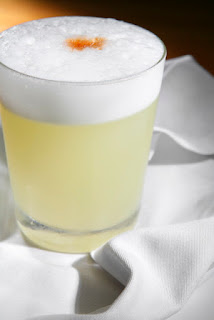Pisco: The Favorite Liquor of Peru (and Chile)
 In
this season of holiday parties with much eggnog and other fattening drinks, I
prefer to choose regional cocktails as a combination dessert-drink. One of my go-tos has always been the Pisco
Sour, a favorite in Peru and Chile.
Pisco is the national liquor of Peru, with a National Pisco Day on July
21, but there is much debate between Peru and Chile as to which country originated
the drink. No matter, pisco is still
relatively unknown here. A wonderful
base for a variety of cocktails, pisco is a clear brandy which is made by
fermenting one or more grapes mixed together, all grown in the coastal desert
plains. It’s also a nice lower-calorie
choice for a shot if you’re tired of tequila (which, by the way, has its only
national holiday just three days later on July 24).
In
this season of holiday parties with much eggnog and other fattening drinks, I
prefer to choose regional cocktails as a combination dessert-drink. One of my go-tos has always been the Pisco
Sour, a favorite in Peru and Chile.
Pisco is the national liquor of Peru, with a National Pisco Day on July
21, but there is much debate between Peru and Chile as to which country originated
the drink. No matter, pisco is still
relatively unknown here. A wonderful
base for a variety of cocktails, pisco is a clear brandy which is made by
fermenting one or more grapes mixed together, all grown in the coastal desert
plains. It’s also a nice lower-calorie
choice for a shot if you’re tired of tequila (which, by the way, has its only
national holiday just three days later on July 24).
Piscos
are divided into ones that are aromatic and those which are not, depending on
the grape or grapes used, similar to other brandies. Quebranta, Negra Criolla, Uvina and Mollar are
made from just one type of non-aromatic grape; aromatic piscos include Moscatel,
Italia and Torontel. You can also try
Acholado or Mosto Verde which contain at least one non-aromatic and one
aromatic grape.
I have to admit that I’m a novice when it comes to pisco; I’m much savvier about
the varieties of blanco, añejo and reposado tequilas. What I’ve started to notice, however, is that
there are quite a few pisco producers, and this becomes important if you prefer
to drink your liquor straight up. Some
of the best brands come from Peru and include Huamani, Campo de Encanto, Cholo
Matias and Torres de la Gala.
 |
| Machu Picchu |
If
you’re planning a trip to Peru – I only had a brief layover in Lima, sadly –
try to visit the area around Ica, south of Lima, where most pisco is
produced. A worthy reward after hiking
Machu Picchu, pisco can be sampled and venerated at the Museo del Pisco
in Cusco. The bar there is dedicated to everything
pisco and will give out samples – oh, for a museum like that in the US! In New York City, I always head to Pomaire in the theater district for a Pisco Sour
fix.
While
I don’t have another South American itinerary planned for the near future, I hope
to go back to Chile soon (Easter Island is probably my favorite exotic
destination) and I’m looking forward to spending real time in Peru. If you’re researching an itinerary or just want
help in planning a trip, South American Vacations can assist.

Comments
Post a Comment